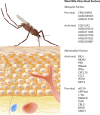West Nile Virus: biology, transmission, and human infection
- PMID: 23034323
- PMCID: PMC3485754
- DOI: 10.1128/CMR.00045-12
West Nile Virus: biology, transmission, and human infection
Abstract
West Nile Virus was introduced into the Western Hemisphere during the late summer of 1999 and has been causing significant and sometimes severe human diseases since that time. This article briefly touches upon the biology of the virus and provides a comprehensive review regarding recent discoveries about virus transmission, virus acquisition, and human infection and disease.
Figures
References
-
- Ader DB, et al. 2004. Modulation of dengue virus infection of dendritic cells by Aedes aegypti saliva. Viral Immunol. 17:252–265 - PubMed
-
- Anderson JF, Andreadis TG, Main AJ, Ferrandino FJ, Vossbrinck CR. 2006. West Nile virus from female and male mosquitoes (Diptera: Culicidae) in subterranean, ground, and canopy habitats in Connecticut. J. Med. Entomol. 43:1010–1019 - PubMed
-
- Anderson JF, et al. 1999. Isolation of West Nile virus from mosquitoes, crows, and a Cooper's hawk in Connecticut. Science 286:2331–2333 - PubMed
-
- Andreadis TG, Anderson JF, Vossbrinck CR, Main AJ. 2004. Epidemiology of West Nile virus in Connecticut: a five-year analysis of mosquito data 1999–2003. Vector Borne Zoonotic Dis. 4:360–378 - PubMed
-
- Appler KK, et al. 2010. Persistence of West Nile virus in the central nervous system and periphery of mice. PLoS One 5:e10649 doi:10.1371/journal.pone.0010649 - DOI - PMC - PubMed
Publication types
MeSH terms
Grants and funding
LinkOut - more resources
Full Text Sources
Medical






